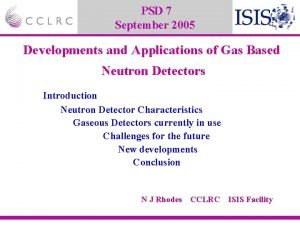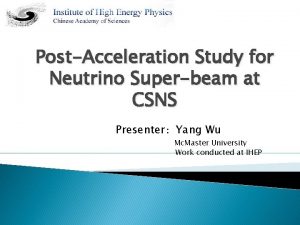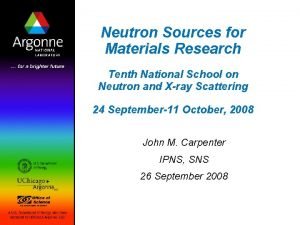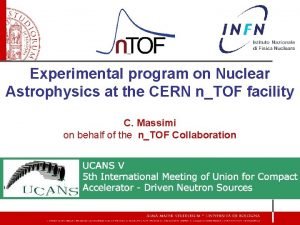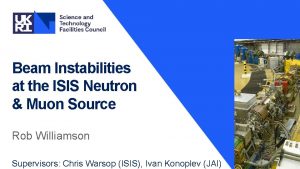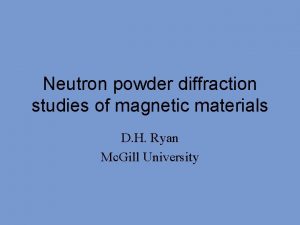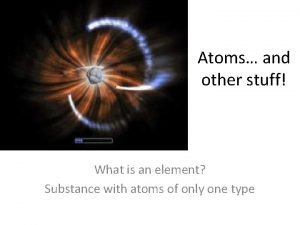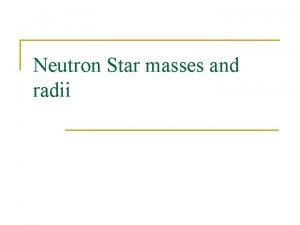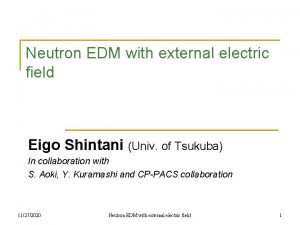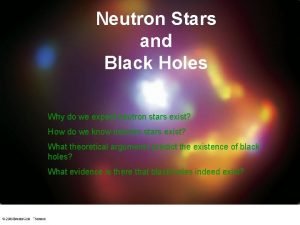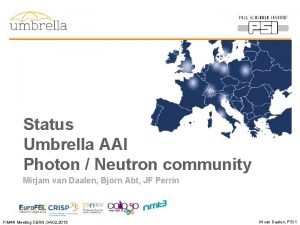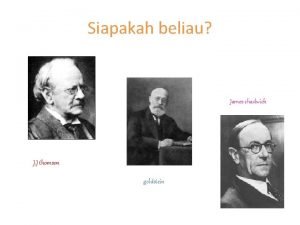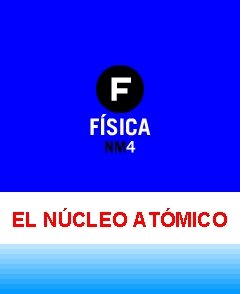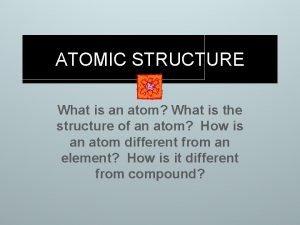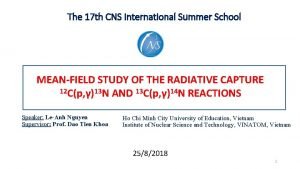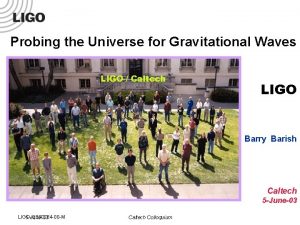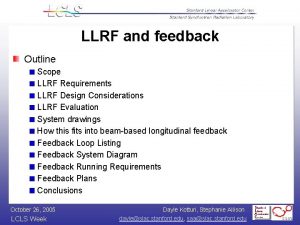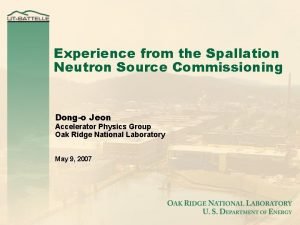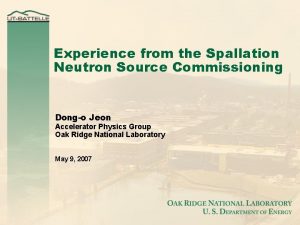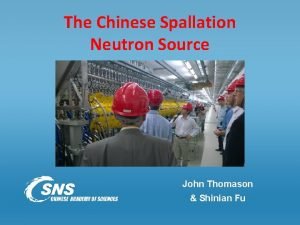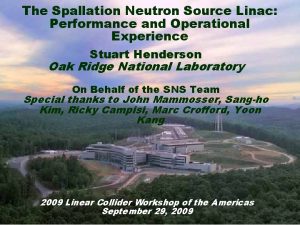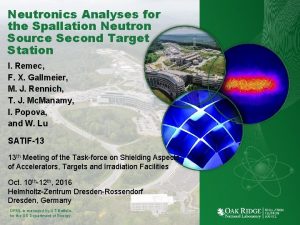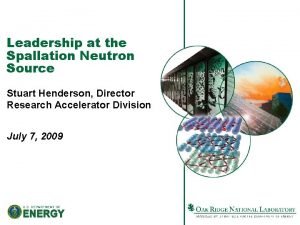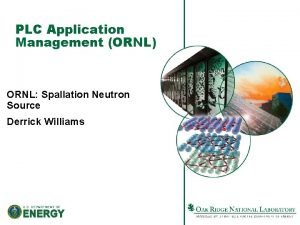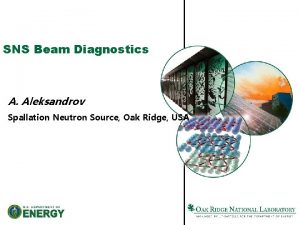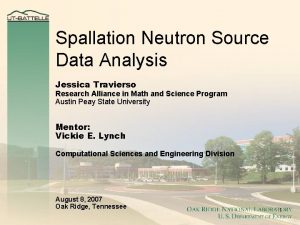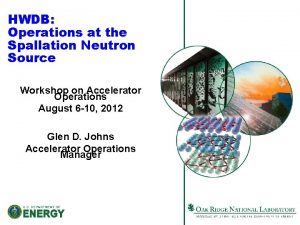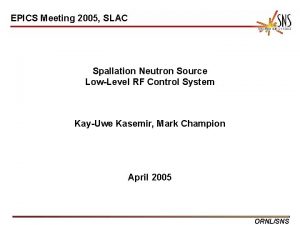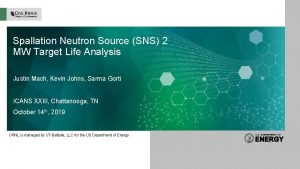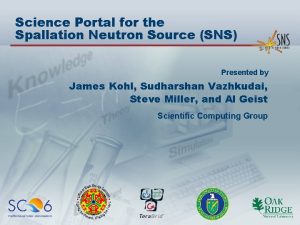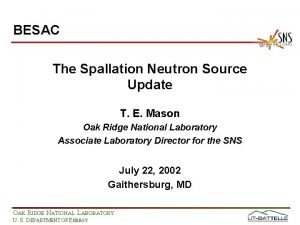LLRF Experience at the Spallation Neutron Source Mark













![Adaptive Feed-forward • Simple approximation method – Correction = K[Kp*error + Ki*error_integral] • Utilized Adaptive Feed-forward • Simple approximation method – Correction = K[Kp*error + Ki*error_integral] • Utilized](https://slidetodoc.com/presentation_image_h2/9a9a936fe2ad609a6c01cdb33a5a9f68/image-14.jpg)




- Slides: 18

LLRF Experience at the Spallation Neutron Source Mark Crofford Eu. CARD 2 Mini Workshop on LLRF and Beam Dynamics Mutual Needs June 2 & 3, 2015 ORNL is managed by UT-Battelle for the US Department of Energy

RF Systems – Outline • Spallation Neutron Source (SNS) Overview • SNS RF Systems – High Power Systems – Low-Level Systems – Reference System • LLRF Performance and Challenges • Cavity Regulation • Errant Beam Issues • Adaptive Feed-Forward and Beam Loss • Downtime Statistics • Summary 2 Eu. CARD 2 Mini Workshop on LLRF

Spallation Neutron Source Ring 1. 4 MW at 1. 0 Ge. V (1. 2 MW now) Pulse on Target 1. 5 E 14 protons (24µC) Macro-pulse in Linac ~1000 mini pulses of ~24 m. A avg over 1 ms at 60 Hz 2. 5 Me. V 87 Me. V 186 Me. V 387 Me. V 1 ms H+ 1 ms beam into 700 ns Current Power on Target H+ Current • Neutron scattering facility to research properties of materials • 1 Ge. V Protons create neutrons through spallation process 670 ns 1000 Me. V HDTL SCL, b=0. 61 SCL, b=0. 81 Target Linac MEBT Current Source CCL 945 ns Mini pulse 1 ms macro-pulse N ~20– 100 x ILL Credit: W. Blokland – IBIC 2013 3 Eu. CARD 2 Mini Workshop on LLRF Flux RFQ H+

SNS High Power RF Systems MEBT RFQ & DTL CCL • 101 RF systems are installed and operational Type Application Frequency Peak Power Vendor Installed Tetrode Ion Source 2 MHz 80 k. W Thales 1 Solid. State MEBT Rebunchers 402. 5 MHz 25 k. W Tomco 4 Klystron RFQ, DTL 402. 5 MHz 2. 5 MW E 2 V & Thales 7 Klystron CCL 805 MHz 5 MW Thales 4 Klystron SCL 805 MHz 550 -700 k. W CPI & Thales 81 Tetrode Accumulator Ring 1 & 2 MHz 500 k. W Thales & CPI 4 4 Eu. CARD 2 Mini Workshop on LLRF SCL Ring

SNS Low-Level RF Systems • Linac LLRF – 402. 5 & 805 MHz – Field Control Module (FCM) – High-power Protection Module (HPM) – Down Converter FCM • Ring LLRF – 1. 05 & 2. 10 MHz – DSP based (Bitt. Ware quad DSP module) – 4 channel ADC module – 4 channel DAC module Down converter Linac LLRF Ring LLRF 5 Eu. CARD 2 Mini Workshop on LLRF HPM

SNS Linac RF Reference System • 402. 5 MHz section serves 11 systems: RFQ, MEBT Rebunchers, and DTL • 805 MHz section serves 85 systems: CCL and SCL • 805 MHz section extends to the end of the Linac tunnel and is ready to support additional RF systems to be installed for the Second Target Station • Reference line is temperature and pressure regulated to improve stability Reference System 6 Eu. CARD 2 Mini Workshop on LLRF

LLRF Performance • The LLRF system continues to operate within specification • Automation has simplified operator interaction and improved cavity recovery – One button cavity startup eliminates operator error • Improvements and features added over time to overcome operational issues – Voltage droop – droop compensation added – Multipacting during cavity fill – slow ramp added to minimize reflected power – RFQ temperature stability - pulse width modulation added to improve temperature stability of the RFQ – Inadequate CPU speed – replaced IOCs with faster models to support full pulse operation 7 Eu. CARD 2 Mini Workshop on LLRF

LLRF Issues • 10 years of successful operation but some failures are starting to manifest • The output amplifier IC for the RF output circuit has shown step variations in the output level – Multiple failures in the past year – Traced the problem to bond wire failures – All amplifier ICs are being replaced during the calibration cycle of the system • System has several obsolete components including the FPGAs – Adequate spares are available – Redesign in consideration 8 Eu. CARD 2 Mini Workshop on LLRF

Cavity Regulation • Specification from the initial SNS Parameters document: – Static RF error: +/- 1 degree, +/- 1 percent – Dynamic RF error: +/- 0. 5 degree, +/- 0. 5 percent – RMS or peak-to-peak error specifications would have been more useful Peak Regulation Error during the Beam Pulse (AFF) Beam Conditions • • • 0, 45 850 k. W on target 26. 3 m. A avg. 37. 8 m. A peak 0, 40 0, 35 Percent 0, 30 0, 25 0, 20 0, 15 0, 10 0, 00 Data taken 3/25/2015 9 Eu. CARD 2 Mini Workshop on LLRF RFQ MEBT 2 MEBT 4 DTL 2 DTL 4 DTL 6 CCL 2 CCL 4 SCL 01 b SCL 02 a SCL 02 c SCL 03 b SCL 04 a SCL 04 c SCL 05 b SCL 06 a SCL 06 c SCL 07 b SCL 08 a SCL 08 c SCL 09 b SCL 10 a SCL 10 c SCL 11 b SCL 12 a SCL 12 c SCL 13 a SCL 13 c SCL 14 a SCL 14 c SCL 15 a SCL 15 c SCL 16 a SCL 16 c SCL 17 a SCL 17 c SCL 18 a SCL 18 c SCL 19 a SCL 19 c SCL 20 a SCL 20 c SCL 21 a SCL 21 c SCL 22 a SCL 22 c SCL 23 a SCL 23 c 0, 05 Cavity

Errant Beam Definition • Abrupt beam loss caused by: – Low current or partial beam pulses – Beam pulses with incorrect energy – Abrupt beam losses • SCL Beam Loss Monitors (BLM) are the primary indication of errant beam 10 Eu. CARD 2 Mini Workshop on LLRF Fast beam current monitor in MEBT Credit: C. Peters – AAC, 2013

Why is Errant Beam Important? • Errant beam mechanism – Beam hitting cavity surface desorbs gas or particulates creating an environment for arcing • Super Conducting Linac (SCL) cavity performance degrades over time – SCL cavities do not trip with every errant beam pulse, but the probability for a trip increases with the frequency of bad pulses – Cavity fields have been decreased and cavities have been turned off resulting in lower beam energy • SCL cavity performance degradation from errant beam can be restored – Requires cavity warm up during a long shutdown and then RF conditioning before resuming beam operation – Cryomodules have been removed from the tunnel for cavity RF coupler repairs but this takes months C. Peters – AAC, 2013 11 Eu. CARD 2 Mini Workshop on LLRF

The Majority of Errant Beam Faults Originate in the Warm Linac • <10% of BLM trips were due to the ion source/LEBT – Most ion source induced BLM trips occur during the first week of a new source installation • High voltage arcing • >90% of BLM trips were due to warm linac RF faults – RF faults occur at different times during the pulse • The majority of faults during the RF fill have reproducible times • Faults during the RF flattop are random – RF fill faults can be reduced • • Adjust the RF field Adjust the RF fill time Change the cavity resonant frequency Vacuum maintenance 12 Eu. CARD 2 Mini Workshop on LLRF Credit: C. Peters – AAC, 2013

Errant Beam Trips Reduced • Initially, ~75% (30 per day) of short trips were caused by errant beam • Errant beam trips have been reduced from 30 to 10 events a day • Green bars are actual errant beam trips. • SNS started specifically recording them in FY 14 • FY 15 reduction was during 850 k. W run FY 11 13 Eu. CARD 2 Mini Workshop on LLRF FY 12 FY 13 FY 14 FY 15 Credit: C. Peters – IPAC, 2015
![Adaptive Feedforward Simple approximation method Correction KKperror Kierrorintegral Utilized Adaptive Feed-forward • Simple approximation method – Correction = K[Kp*error + Ki*error_integral] • Utilized](https://slidetodoc.com/presentation_image_h2/9a9a936fe2ad609a6c01cdb33a5a9f68/image-14.jpg)
Adaptive Feed-forward • Simple approximation method – Correction = K[Kp*error + Ki*error_integral] • Utilized for cavity filling and pulse-to-pulse feedback – Dual AFF buffers – Cavity filling AFF provides additional RF power to speed cavity filling • Ramp shape • Droop correction – Pulse-to-pulse provides correction for repetitive errors cause by beam loading, modulator ripple, and Lorentz force detuning 14 Eu. CARD 2 Mini Workshop on LLRF

Adaptive Feed-forward & Beam Loss • The adaptive feed-forward is sufficient but the learning speed of the algorithm could be improved • Most noticeable during Physics shifts – 1 Hz operation – Beam setup variations • Learning is iterative, beam is lost during learning – AFF calculations occur at the IOC – limited to 20 Hz – Does not compensate for non-repetitive errors – Some guaranteed beam loss! • Improvements to the algorithm are being investigated 15 Eu. CARD 2 Mini Workshop on LLRF

RF Downtime – May 2013 to April 2015 • Total Downtime 265 hours out of 10303 scheduled Accelerator Physics/Neutron Production hours (2. 57%) • Warm Linac accounts for the majority of downtime 50 45 40 35 30 25 Total Downtime Beam Downtime 20 15 10 5 16 Eu. CARD 2 Mini Workshop on LLRF L 4 C C L 3 C C L 2 C C L 1 C C 6 TL D 5 TL D 4 TL D 3 TL D 2 TL D 1 TL D T 1 M EB T 2 M EB T 3 M EB T 4 EB M R FQ 0

RF Downtime (cont. ) • Occasional major event quickly adds to the system downtime but this is only ~20% of the total downtime – DTL 6 circulator failure – 17 hours (June 2014) – CCL 2 klystron failure – 14 hours (May 2014) – CCL 3 klystron failure – 16 hours (Oct 2014) • Majority of warm linac trips are ~ 20 – 30 minutes in duration – Cavity and window arcing – Vacuum excursions/bursts • SC linac trips are ~5 – 10 minutes in duration – Errant beam • Overall reliability of the RF systems is very good – Continue to seek ways to improve the systems 17 Eu. CARD 2 Mini Workshop on LLRF

Summary • RF systems reliability is sufficient to achieve neutron production availability >90% • Improvements in the LLRF and automation have simplified operation • Better understanding of errant beam causes has resulted in the reduction of downtime • Adaptive feed-forward was instrumental in achieving regulation requirements but there is room for improvement 18 Eu. CARD 2 Mini Workshop on LLRF
 Spallation neutron source
Spallation neutron source Spallation neutron source
Spallation neutron source Neutron fission
Neutron fission Cristian massimi unibo
Cristian massimi unibo Isis neutron and muon source
Isis neutron and muon source Direct vs indirect experience
Direct vs indirect experience Imprinting psychology
Imprinting psychology Early experience vs later experience
Early experience vs later experience Magnets for neutron diffraction
Magnets for neutron diffraction Hydrogen isotope with 1 neutron
Hydrogen isotope with 1 neutron Neutron star
Neutron star Neutron
Neutron Anatomy of a star
Anatomy of a star Mirjam van daalen
Mirjam van daalen Jumlah maksimum elektron pada kulit n adalah
Jumlah maksimum elektron pada kulit n adalah Masa del neutron
Masa del neutron Mass of neutron
Mass of neutron Fhbdf
Fhbdf Binary neutron star
Binary neutron star
